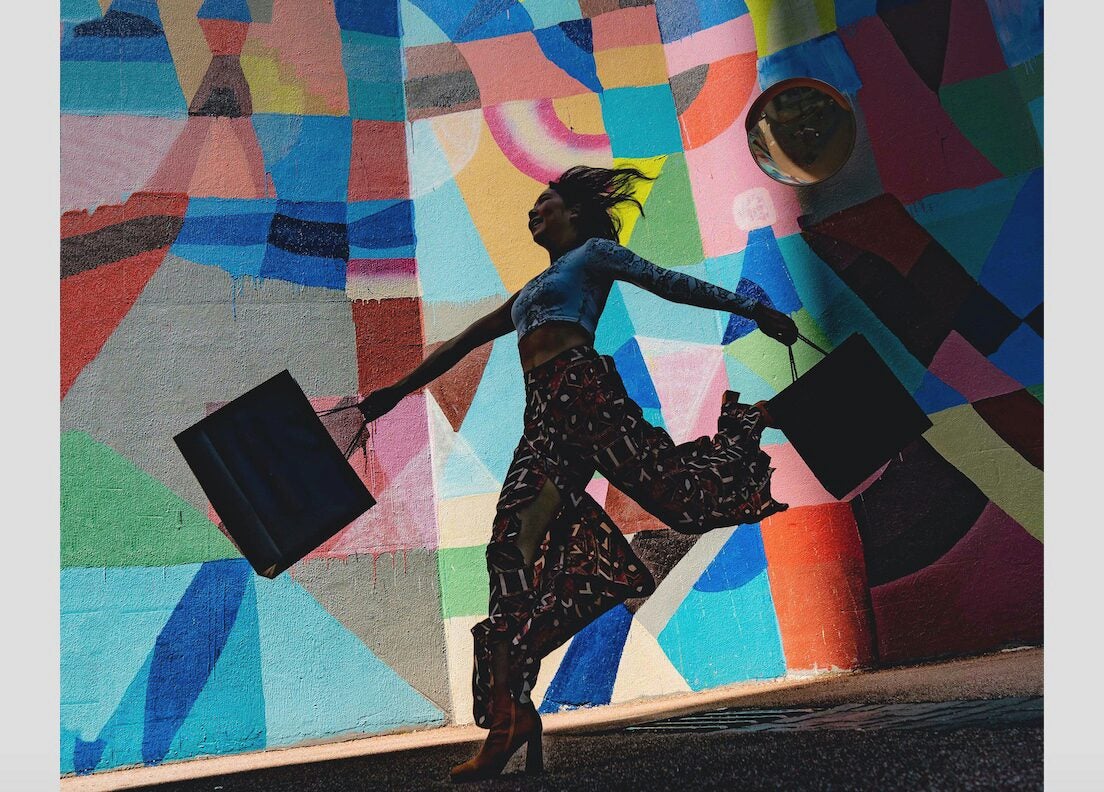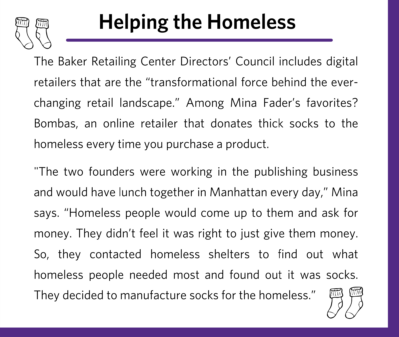The Baker Retailing Center on What’s in Style in the Shopping Business


Wharton’s Jay H. Baker Retailing Center, a retail think tank that supports the exchange of ideas, insights and research between the industry, Wharton School faculty and students, is always watching the latest trends. Mina Fader, managing director of the center, says, “The nice thing about retail is that everybody can relate to it.” In other words, we are all consumers, from Zoomers to Boomers. And, in fact, the younger generations are having a powerful influence on the way retailers think and sell.
So, what’s in vogue these days in an industry that is constantly changing? In her role as listener, observer and data devotee, here’s Mina’s top 5 list of retail business revolutions:
🛍️ Challenges. The retail industry is confronted with the worst supply chain troubles on record, inflation and labor shortages that affect the sales, prices and availability of products on the consumer side. A Baker Retailing Center study confirms that retail executives overwhelmingly agree supply chain woes will continue to impact the industry for years. Increased costs of goods and shipping often mean higher prices for shoppers.
🛍️ Technology. The COVID-19 pandemic hit the retail industry hard, and yet those companies who had already embraced technology (online stores!) were well positioned to thrive, especially during lockdown. The second piece to this is that physical stores are working hard to understand how they fit into this tech-driven shopping environment. “It’s about understanding what the consumer is interested in and why he or she is driven to go to a store,” says Mina. “People don’t go to the store and work with the sales associate the same way they used to. Now the questions are: Where did the shoes come from? How were they made? Is it sustainable? What do you know about this brand? The customer experience has become much more important in the store environment, because a lot of people are going to the store to either gain more information and purchase it online, and/or they’ve done a lot of research online and they just want to touch and feel the product.”
🛍️ Brand Ambassadors. Retail companies are calling on everyday social media influencers to authentically show off their styles. “If you have a certain style about you that matches the culture or the brand image, companies are directly instant messaging students and asking if they would like to be a brand ambassador,” notes Mina. “It’s amazing how many of our Penn students are mini-influencers who have a significant amount of followers, like Xiye Bastida.”
🛍️ Individuality. The retail industry is embracing diversity in all ways, celebrating the Black Lives Matter movement, gender fluidity, and more. “The retail industry is trying to reach a broader group of people,” says Mina. “This is a recognition from brands and the retail industry that not everybody is the same, or everybody is unique. Beauty is a good example. To have product that matches your skin tone and hair product specifically for your type of hair. You’re seeing it across apparel and different areas.”
🛍️ Purpose. The younger generations who care deeply about the environment, sustainability and social awareness (and are even willing to pay more for products that align with causes) are prompting all retailers to rethink their brands. It’s a work in progress, says Mina. “These traditional organizations that have been around for a long time and this was not part of their DNA realize consumers care about this and so they should care about it. But then how do you bring it forward in an authentic matter so the consumer knows you’re serious about it? Again, that authenticity is key.” This extends to resale and rental, two important retail trends that are being driven by teens’ and twentysomethings’ passion for a circular economy – reusing and rewearing materials and products for as long as possible to keep them out of the landfills. Direct-to-consumer retailers like ThredUp are all about the thrifting – and even established retailers are getting into this thriving market.

Conversation Starters
Do you know or follow any young brand ambassadors on social media? How did they get the job and do you feel what they’re doing is authentic?
What’s your favorite example of a retail brand embracing social purpose?
Describe your most recent experience shopping in a physical store? What was it like? Did you approach it like a showroom and then actually buy things online? How, if at all, did you engage with the salesperson?
Thanks to Mina, we have heard about the most pertinent issues and business revolutions affecting our retail industry today. It is nice to see how retailers are recognizing individuality and moving toward more inclusiveness. As much as we all enjoy being part of a group, we also really value our own identity. I also think that brand ambassadors truly serve as mini-influencers who play a vital role in the marketing of retail products. However, I hope the selection of these ambassadors goes beyond just the most popular individuals on TikTok or YouTube. It would be nice to see a broad representation of influencers, including everyday classmates or neighbors.
The fashion industry is constantly changing- people are more willing to follow the trends than develop their own style, based on the influencers they follow. We need to see a more diverse group of influencers sponsored by brands, such as people of color and different sized bodies, as our generation tries to mimic what they see on social media, and often blame themselves when they don’t match how their favorite influencers look. With this comes the wave of “is it a fit or is she just skinny ?”. Seeing outfits on our favorite influencers who look like us give us the confidence to bring our own style, and know what looks good on us. As trends change, brands try to curate their clothing to center around what they know people will buy. Because what is “in” is changing with the trends, brands often turn to fast-fashion to keep up with what’s trending on social media. This leads them to use non-ethical ways to produce or design their clothing; exploiting their workers, leaving an even larger carbon footprint with large production plants, and stealing from smaller designers. Fast-fashion is not just cheap because of labor and production costs, but trendy, leading more and more people to buy from them because it fits the trends and won’t cost much. However, this takes away from small businesses and clothing brands that use slow-fashion (making their own clothes by hand, having a team of well paid workers, etc) to fall behind because people are so used to lower prices and think these brands are “overpriced”, when they are actually fairly paying their workers and are considerate of company ethics.
The consumer shopping experience is beyond the buying and selling of goods and services. Our desire to be satisfied with both ourselves as well as our purchases drive us to favor businesses that provide high-quality goods for a low price while still taking vogue, consciousness, and authenticity into consideration. But what makes a shopping experience so memorable and striking? One of my most unforgettable experiences as an avid shopper and fashion lover was visiting the Gentle Monster store in Singapore. Unlike the typical retail store with shelves and a crowded display, the South Korean fashion brand had several abstract art installations as part of their store’s interior. Each store has different installations made by different artists that would serve as an illustration of the store’s concept and deliver a unique message. For instance, their Singapore flagship piece titled “THE DATA ADDICT” showcases the digital world, online news, and authenticity using 3D technology and real-life antennas. As a customer, I am able to sense the brand’s originality, cause, and identity through their extraordinary expression and presentation. I can enjoy the fun of exploring their stores and feel excited to visit their next one. I believe that it is original concepts like this that truly leave an impression on customers. Whether or not you left the store with a new pair of sunglasses, the shopping (or viewing) experience is certainly one of a kind.
Reading this brought me back to last summer when I participated in an entrepreneurship camp – Future of the Business World. We were asked to come up with ideas and designs for new products, but after several rounds of brainstorming we realized that our best ideas had all been done before.
This article touches upon trends in retail which I witnessed myself as well, both as a small business owner and as a consumer. I’d like to dive deeper into the topic of purpose in this space, with both of these perspectives in mind.
Since the advent of the internet, building a retail business has become markedly easier. A cohesive supply chain can be developed in a matter of weeks with the right vision and planning. Developing a product, finding a manufacturer, building an online shop, marketing, delivery, finance and customer service can all be orchestrated from the comfort of your own home, and at a bewilderingly low entry cost. Competition in retail has expectedly skyrocketed and that’s a major causal factor behind the unfortunate conclusion my classmates and I came to last summer.
Now, I understood the conclusion was a little discouraging, but not entirely so, as I had the tools to try my hand at retail without much cost for failure.
I found my corner of the retail industry in stationery, with an ever-changing range of products which allows me to be creative with design – something I have enjoyed for a long time. So this part of the business doesn’t feel all too much like work. Wanting to be creative anyway means I have ample intrinsic motivation to develop my range on offer, and this, in turn, helps me to acquire and retain customers by appealing to an audience which resonates with my art. This has been immensely rewarding for me.
I’ve experimented with manufacturers from different countries to find the best materials, prices, and quality for me, and I’ve had the privilege of applying classroom learnings such as price skimming to my real business strategy!
Environmental sustainability is something I do hold close to my heart and I try to stay true to that
with my personal consumer habits: by buying from companies who’ve made progress towards
carbon neutrality, and by reselling items I no longer use so the economy can be more circular, rather than cliff-edged with a landfill on the shore.
So while I do agree that retail is an effective tool to drive purposeful improvements in production
and consumption practices, I believe there is another facet to purpose in retail. I think there is a
beauty to be admired in the creativity that it rewards, in stepping beyond the threshold from the
academic to the practical, and in the globally interconnected realization of an idea.